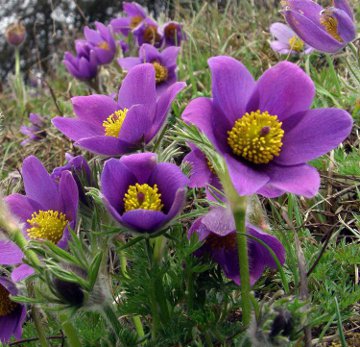 Pulsatilla
vulgaris (Anemone pulsatilla)
Pulsatilla
vulgaris (Anemone pulsatilla)Wild Pasque Flower
A native of Europe, where it is often planted on graves, pasque flower grows wild from Great Britain to the Ukraine. Pasque flower is ruled by Mars because its sap is acrid and burning and because it is hairy, which is a type of thorniness in plants. All pasque flowers are considered protective, especially against negative magick and evil spirits. Historically people might carry a pasque flower wrapped in a red cloth for this purpose. Pasque flowers are thought to be especially effective for protecting the home when grown around it. In Scotland, picking this plant was believed to cause thunderstorms, and it was called Thunderbolt, which gives this plant an interesting connection to various thunder gods. As its name indicates, this magick herb flowers in early spring (March-April), at the time of Ostara/Easter and Passover. The 2-4" flowers appear even before the gray-green ferrn-like leaves are developed. Fairies are said to sleep inside the closed flowers at night. The flowers fade to silky seed heads that pulse in the smallest breeze, giving this plant the name pulsatilla and wind flower or wind anemone. Top
How to grow pasque flower: Sow in Jiffy-7 or other sterile planting medium (or folded into a wrung-out paper towel kept in a baggie) and keep moist (not sopping) at room temperature (about 63-72F/18- 22°C) for 2-4weeks. Some seeds will germinate at that termperature, but if they do not, chill to 25-39F/-4-+4 C) for another 4-6 weeks (freezer will work). Then put in cool temperatures (41-54F/5-12C) for germination. Or sow on Winter Solstice (see special directions on the Solstice Sowing page). Once they germinate, transplant to moist, rich soil and full sun up north to partial shade farther south. General growing info. Top
Pulsatilla
vulgaris
Pasque Flower
20 seeds $4.00
Uses in Witchcraft & Magic:
Honoring the Dead
Protection Spells/Charms
Storm Magick
Mars Herb
© 2004-2024 Alchemy Works; No reproduction without permission